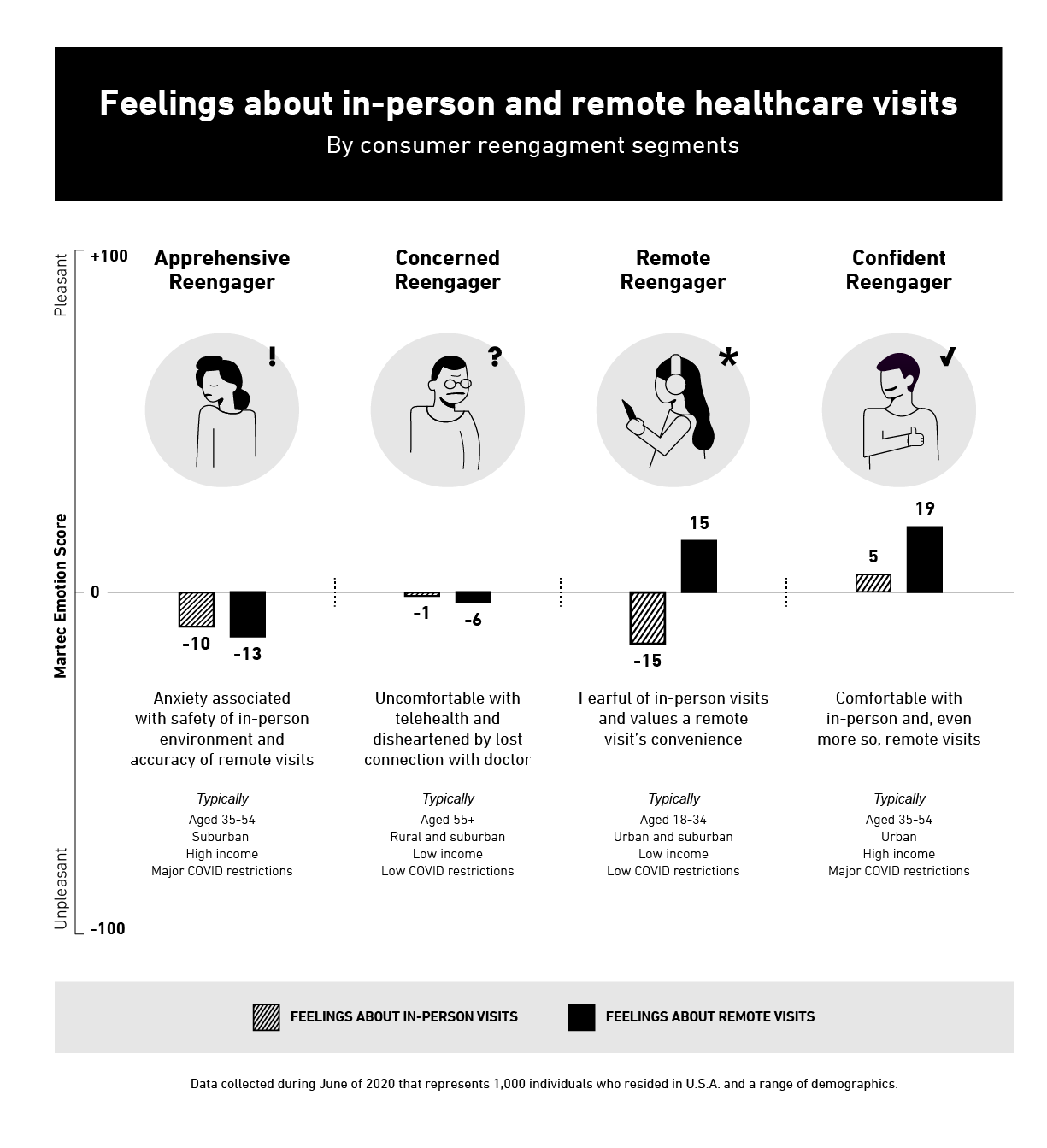Sponsors

Never has it been more important for health system executives and physicians to understand, at a deeper level, what drives consumers’ decisions to seek healthcare services. When the COVID-19 pandemic emerged, hospitals were forced to stop all but the most urgent non-COVID care. The impact for health systems has been an unprecedented and dramatic loss of revenue and climbing expenses.
Today, healthcare organizations are struggling to reengage apprehensive patients.
To give health system decision-makers and stakeholders insight into U.S. consumers’ attitudes, behaviors and emotions amid the pandemic, the healthcare division of Motion partnered with the Martec Group to design one of the most in-depth explorations to date. In June, we surveyed 1,000 people across the country, with a mix of residents in states with major, moderate and minor COVID-19 stay-at-home and social distancing restrictions. Our study leveraged Martec’s proprietary Emotion Intelligence (EI) methodology to move beyond participants’ conscious responses to unearth decision-driving nonconscious feelings.
Emotions Subconsciously Drive Healthcare Decisions
“Research shows that 95 percent of cognitive activity takes place on the nonconscious ‘fast track,’ as opposed to the slow, logical plain of conscious thought,” says Chuck Bean, Partner and Chief Marketing Officer at Martec. “And when it comes to making decisions, people really do go with their gut.”
The Martec EI process maps respondents’ words to 32 different emotion channels, ranging from the most positive (loyalty, kindness, acceptance and interest, for example) to the most negative (contempt, anger, rejection, disinterest). A layered questioning approach categorizes respondents’ chosen emotion words and their relative intensity to drill below the surface of conscious into nonconscious reactions, often unveiling a telling disconnect between what people say and what they feel.
Using this methodology, here’s what we found:
- Four pivotal areas drive consumers’ emotions and decisions about re-engaging with healthcare providers:
- Personal relationships: Feeling a strong connection to their physician
- Safety: Concerns about getting infected by COVID-19 in a healthcare setting
- Trust: Perceived accuracy of diagnosis and treatment with telemedicine
- Convenience: No travel time
- The nationwide study documents a dramatic 45% increase in consumers’ concern over being in a hospital or doctor’s office since the onset of COVID-19
- Consumers are apprehensive about both remote and in-person healthcare services, and they’re largely ambivalent toward telemedicine.
- More than half of consumers have now experienced a remote visit with a healthcare provider, up from 31% in February. Among those who haven’t yet had a virtual visit, one-third say they’re highly likely to consider one.
- The largest percentage of both groups—46% of telehealth users and 53% of non-users—are neutral about future engagement with their provider. They’re intrigued, but they still need to be won over.
“There are clearly tradeoffs with remote healthcare,” says study co-author Jim Durkin, Founding Partner, Martec. “While 40% of respondents indicate missing the structure of in-person visits with their physicians, the lure of no wait times and easily getting appointments could balance that out.”
Know Your Patients: Four Distinct Consumer Segments
It’s important to understand the variety in sentiments consumers feel toward receiving healthcare amid the pandemic. Our study identified four unique consumer segments with significantly varying viewpoints on re-engaging with the healthcare ecosystem:
- The Apprehensive Reengager: They’re the most concerned about both in-person and telemedicine visits.
- The Concerned Reengager: They prefer in-person visits with their physician but are concerned for their safety.
- The Remote Reengager: They strongly prefer remote visits.
- The Confident Reengager: They have a strong preference for a remote visit but are open to seeing their physician in person when necessary.
The chart below shows differences in the four segments.

Implications for Healthcare Providers
With COVID-19 infections predicted to rise this fall and winter, health systems located in hot spots risk a second wave of business interruption, a drop in patient visits, a decline in surgeries and lost revenue.
There’s no one-size-fits-all solution to mitigating these detrimental impacts. To succeed in getting more patients to return and continue using healthcare services, providers need to customize their outreach to each of the four consumer segments, meeting patients at their preferred form or forms of re-engagement.
Here are some additional steps providers should take:
- Establish more frequent touch-points with patients: This can help patients work through their insecurities about reengaging with the healthcare system. Particularly critical is addressing safety concerns around the use of emergency rooms and urgent care, as our study found consumers are especially reluctant to return to these facilities due to a fear of exposure to individuals with the virus.
- Educate patients on telehealth: The rapid adoption of telehealth during the early stages of COVID-19 afforded health systems no time to teach consumers when and how to best use virtual care. Now, providers have the opportunity to take a step back and help patients identify when a virtual visit may provide a valuable adjunct to in-person treatment.
- Prioritize the patient experience: Addressing patient experience dissatisfaction at this critical junction is imperative to mitigating the loss of patient visits, procedures and revenue. Successful providers will accelerate the redesign of the patient experience—both in-person and remotely—to ensure offerings center on patients’ convenience, not their own. Healthcare providers that address patient insecurities and information gaps will do better.
For more information on the survey, or to request full research findings, contact Carie Pflug at cpflug@agencyinmotion.com.
Visit: https://agencyinmotion.com/healthcare/
Click here to learn more about how a healthcare marketing agency can help.